Red panda
The red panda (Ailurus fulgens) is a mammal species native to the eastern Himalayas and southwestern China. It is listed as Endangered on the IUCN Red List because the wild population is estimated at fewer than 10,000 mature individuals and continues to decline due to habitat loss and fragmentation, poaching, and inbreeding depression.[1] Despite its name, it is not closely related to the giant panda.[3]
| Red panda | |
|---|---|
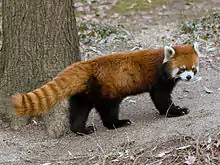 | |
| A red panda at the Cincinnati Zoo | |
| Scientific classification | |
| Kingdom: | Animalia |
| Phylum: | Chordata |
| Class: | Mammalia |
| Order: | Carnivora |
| Family: | Ailuridae |
| Genus: | Ailurus F. Cuvier, 1825 |
| Species: | A. fulgens |
| Binomial name | |
| Ailurus fulgens F. Cuvier, 1825 | |
| Subspecies | |
|
A. f. fulgens (Himalayan red panda) F. Cuvier, 1825 | |
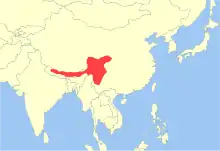 | |
| Range of the red panda | |
The red panda has reddish-brown fur, a long, shaggy tail, and a waddling gait due to its shorter front legs; it is roughly the size of a domestic cat, though with a longer body. It is arboreal and feeds mainly on bamboo, but also eats eggs, birds, and insects. It is a solitary animal, mainly active from dusk to dawn, and is largely sedentary during the day. It is also called the lesser panda, the red bear-cat, and the red cat-bear.[4]
The red panda is the only living member of the genus Ailurus and the family Ailuridae. It has previously been placed in the raccoon and bear families, but the results of phylogenetic analysis provide strong support for its taxonomic classification in its own family, Ailuridae, which is part of the superfamily Musteloidea, along with the weasel, raccoon and skunk families.[5] Traditionally it was thought to consist of two subspecies.[6] However, results of genetic analysis indicate that there are probably two distinct red panda species, the Chinese red panda and the Himalayan red panda, which genetically diverged 0.22 million years ago.[7]
Physical characteristics
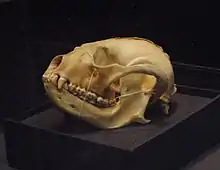
The red panda has long, soft, reddish-brown fur on the upper parts, blackish fur on the lower parts, and a light face with tear markings and white badges similar to those of a raccoon, but each individual can have distinctive markings. Its skull is roundish with medium-sized upright ears, its nose is black, and its eyes are blackish. Its teeth are robust. Its long, bushy tail with six alternating transverse ochre rings provide balance and excellent camouflage in a habitat with moss- and lichen-covered trees. The legs are black and short with thick fur on the soles of the paws. This fur serves as thermal insulation on snow-covered or icy surfaces and conceals scent glands, which are also present on the anus.[8]
The head and body length of a red panda measures 50 to 64 cm (20 to 25 in), and its tail is 28 to 59 cm (11 to 23 in) long. Males weigh 3.7 to 6.2 kg (8.2 to 13.7 lb) and females 3 to 6.0 kg (6.6 to 13.2 lb).[9]
The red panda is specialized as a bamboo feeder with strong, curved and sharp semi-retractile claws[9] standing inward for grasping narrow tree branches, leaves, and fruit. Like the giant panda, it has a "false thumb", which is an extension of the wrist bone. When descending a tree head-first, the red panda rotates its ankle to control its descent, one of the few climbing species to do so.[10]
Distribution and habitat
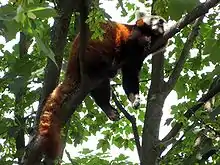
The red panda is endemic to the temperate forests of the Himalayas, and ranges from the foothills of western Nepal to China in the east.[11] Its easternmost limit is the Qinling Mountains of the Shaanxi Province in China. Its range includes southern Tibet, Sikkim and Assam in India, Bhutan, the northern mountains of Burma, and in south-western China, in the Hengduan Mountains of Sichuan and the Gongshan Mountains in Yunnan. It may also live in south-west Tibet and northern Arunachal Pradesh, but this has not been documented. Locations with the highest density of red pandas include an area in the Himalayas that has been proposed as having been a refuge for a variety of endemic species in the Pleistocene. The distribution range of the red panda should be considered disjunct, rather than continuous.[9] A disjunct population inhabits the Meghalaya Plateau of north-eastern India.[12]
The red panda lives between 2,200 and 4,800 m (7,200 and 15,700 ft) altitude, inhabiting areas of moderate temperature between 10 and 25 °C (50 and 77 °F) with little annual change. It prefers mountainous mixed deciduous and conifer forests, especially with old trees and dense understories of bamboo.[9][11]
During a survey in the 1970s, signs of red pandas were found in Nepal's Dhorpatan Hunting Reserve.[13] Their presence was confirmed in spring 2007 when four red pandas were sighted at elevations ranging from 3,220 to 3,610 m (10,560 to 11,840 ft).[14] Its westernmost distribution is in Rara National Park.[15][16] In 2018, red pandas were sighted at elevations of 3,150–3,650 m (10,330–11,980 ft) in Nepal's Lamjung District.[17]
The red panda population in Sichuan Province is larger and more stable than the Yunnan population, suggesting a southward expansion from Sichuan into Yunnan in the Holocene.[18] The red panda has become extirpated from the Chinese provinces of Guizhou, Gansu, Shaanxi, and Qinghai.[19]
Behavior and ecology
Behavior
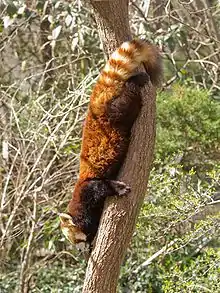
The red panda is territorial; it is solitary except during mating season. It is generally quiet except for some twittering, tweeting, and whistling communication sounds. It has been reported to be both nocturnal and crepuscular, sleeping on tree branches or in tree hollows during the day and increasing its activity in the late afternoon and early evening hours. It sleeps stretched out on a branch with legs dangling when it is hot, and curled up with its tail over the face when it is cold.[9] It is very heat-sensitive, with an optimal "well-being" temperature between 17 and 25 °C (63 and 77 °F).[20]
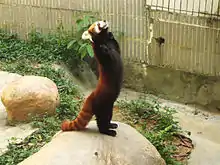
Shortly after waking, red pandas clean their fur somewhat like a cat would, licking their front paws and then rubbing their backs, torsos, and sides. They also rub their backs and bellies along the sides of trees or rocks. Then they patrol their territories, marking with urine and a weak musk-smelling secretion from their anal glands. They search for food running along the ground or through the trees. Red pandas may use their forepaws alternately to bring food to their mouths or place food directly into their mouths.[9]
Predators of the red panda include the snow leopard (Panthera uncia), mustelids, and humans. If they feel threatened or sense danger, they may try to escape by climbing a rock column or tree. If they can no longer flee, they stand on their hind legs to make themselves appear larger and use the sharp claws on their front paws to defend themselves. A red panda became a visitor attraction in Japan for his ability to stand upright for ten seconds at a time.[21]
Diet
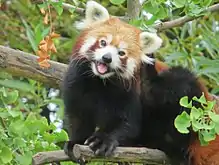
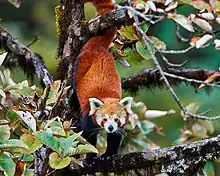
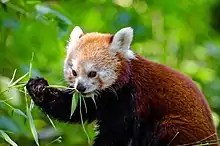
Red pandas are excellent climbers, and forage largely in trees. They eat mostly bamboo, and may eat small mammals, birds, eggs, flowers, and berries. In captivity, they were observed to eat birds, flowers, maple and mulberry leaves, and bark and fruits of maple, beech, and mulberry.[9]
Like the giant panda, they cannot digest cellulose, so they must consume a large volume of bamboo to survive. Their diets consist of about two-thirds bamboo, but they also eat mushrooms, roots, acorns, lichens, and grasses. Occasionally, they supplement their diets with fish and insects. They do little more than eat and sleep due to their low-calorie diets.[22][23]
Bamboo shoots are more easily digested than leaves, exhibiting the highest digestibility in summer and autumn, intermediate digestibility in the spring, and lowest digestibility in the winter. These variations correlate with the nutrient contents in the bamboo. Red pandas process bamboo poorly, especially the cellulose and cell wall components. This implies microbial digestion plays only a minor role in their digestive strategy. To survive on this poor-quality diet, they have to eat the high-quality sections of the bamboo plant, such as the tender leaves and shoots, in large quantities, over 1.5 kg (3.3 lb) of fresh leaves and 4 kg (8.8 lb) of fresh shoots daily. This food passes through the digestive tract fairly rapidly (about 2–4 hr) so as to maximize daily nutrient intake.[24] Red pandas can taste artificial sweeteners, such as aspartame, and are the only nonprimates known to be able to do so.[25]
Reproduction
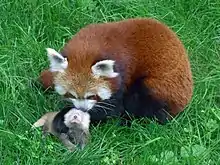
Red pandas are able to reproduce at around 18 months of age, and are fully mature at two to three years. Adults rarely interact in the wild except to mate. Both sexes may mate with more than one partner during the mating season from mid-January to early March.[26] A few days before birth, females begin to collect material, such as brushwood, grass, and leaves; to build a nest, which is normally located in a hollow tree or a rock crevice. After a gestation period of 112 to 158 days, the female gives birth in mid-June to late July to one to four (usually 1–2) blind and deaf cubs weighing 110 to 130 g (3.9 to 4.6 oz) each.[9]
After birth, the mother cleans the cubs, and can then recognize each by their smell. At first, she spends 60% to 90% of her time with the cubs. After the first week, the mother starts spending more time outside the nest, returning every few hours to nurse and groom the cubs. She moves the young frequently among several nests, all of which she keeps clean. The cubs start to open their eyes at about 18 days of age. By about 90 days, they achieve full adult fur and coloring, and begin to venture out of the nest. They also start eating solid foods at this point, weaning at around six to eight months of age. The cubs stay with their mother until the next litter is born in the following summer. Males rarely help raise the young, and only if they live in pairs or in small groups.[9]
A red panda's lifespan ranges between eight and 10 years, but individuals have been known to reach 15 years.[27]
Threats
The primary threats to red pandas are direct harvest from the wild, live or dead, competition with domestic livestock resulting in habitat degradation, and deforestation resulting in habitat loss or fragmentation. The relative importance of these factors is different in each region, and is not well understood.[11] For instance, in India, the biggest threat seems to be habitat loss followed by poaching, while in China, the biggest threat seems to be hunting and poaching.[1] A 40% decrease in red panda populations has been reported in China over the last 50 years, and populations in western Himalayan areas are considered to be lower.[19]
Deforestation can inhibit the spread of red pandas and exacerbate the natural population subdivision by topography and ecology, leading to severe fragmentation of the remaining wild population. Fewer than 40 animals in four separate groups share resources with humans in Nepal's Langtang National Park, where only 6% of 1,710 km2 (660 sq mi) is preferred red panda habitat. Although direct competition for food with domestic livestock is not significant, livestock can depress bamboo growth by trampling.[28]
Small groups of animals with little opportunity for exchange between them face the risk of inbreeding, decreased genetic diversity, and even extinction. In addition, clearcutting for firewood or agriculture, including hillside terracing, removes old trees that provide maternal dens and decreases the ability of some species of bamboo to regenerate.[11]
In south-west China, red pandas are hunted for their fur, especially for the highly valued bushy tails, from which hats are produced. In these areas, the fur is often used for local cultural ceremonies. In weddings, the bridegroom traditionally carries the hide. The "good-luck charm" red panda-tail hats are also used by local newly-weds.[19] This practice may be quite old, as the red panda seems to be depicted in a 13th-century Chinese pen-and-ink scroll showing a hunting scene. Little or no mention of the red panda is made in the culture and folklore of Nepal.[29]
In the past, red pandas were captured and sold to zoos. In an article appearing in the International Zoo News in 1969, one reported he personally had handled 350 red pandas in 17 years.[30]
Due to CITES, this zoo harvest has decreased substantially in recent years, but poaching continues, and red pandas are often sold to private collectors at exorbitant prices. In some parts of Nepal and India, red pandas are kept as pets.[31]
The red panda has a naturally low birth rate (usually one single or twin birth per year), and a high death rate in the wild.
Conservation
.jpg.webp)
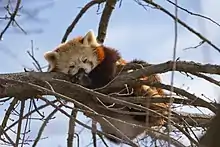
The red panda is listed as endangered on the IUCN Red List since 2008 because the global population is estimated at about 10,000 individuals, with a decreasing population trend; only about half of the total area of potential habitat of 142,000 km2 (55,000 sq mi) is actually being used by the species. Due to its shy and secretive nature, and its largely nocturnal habits, observation of red pandas is difficult. Therefore, population figures in the wild are determined by population density estimates and not direct counts. It is protected in all range countries, and hunting is illegal. It is listed in CITES Appendix I.[1]
Worldwide population estimates range from fewer than 2,500[26] to between 16,000 and 20,000 individuals.[12] In 1999, the total population in China was estimated at between 3,000 and 7,000 individuals.[19] In 2001, the wild population in India was estimated at between 5,000 and 6,000 individuals.[12] Estimates for Nepal indicate only a few hundred individuals.[32] Reliable population numbers are hard to find, partly because other animals have been mistaken for the red panda. For instance, one report from Myanmar stated that red pandas were still fairly common in some areas; however, the accompanying photographic proof of the "red panda" was in fact a viverrid species.[33]
Conservation efforts are highly variable between countries:
- China has 35 protected areas, covering about 42.4% of red panda habitat.[1]
- India has 20 protected areas with known or possible red panda populations in Sikkim, Arunachal Pradesh, and West Bengal such as Khangchendzonga, Namdapha and Singalila National Parks, and a coordinated conservation policy for the red panda.[1]
- In Nepal, known populations occur in Langtang, Sagarmatha, Makalu Barun and Rara National Parks, Annapurna Conservation Area, Kanchenjunga Conservation Area, and Dhorpatan Hunting Reserve.[34]
- Five protected areas in Bhutan support red panda populations.[1]
- Myanmar has 26 protected areas, of which at least one hosts red panda populations.[1]
In situ initiatives
A community-managed forest in Ilam District of eastern Nepal is home to 15 red pandas which generate household income through tourism activities, including homestays. Villagers in the high-altitude areas of Arunachal Pradesh have formed the Pangchen Red Panda Conservation Alliance comprising five villages with a community-conserved forest area of 200 km2 (77 sq mi) at an altitude of 2,500 m (8,200 ft) to over 4,000 m (13,000 ft).[35]
In captivity

The international red panda studbook is currently managed at Rotterdam Zoo in the Netherlands. In cooperation with the International Red Panda Management Group, they coordinate the Species Survival Plan in North America, the European Endangered Species Programme in Europe, and other captive-breeding programs in Australia, India, Japan, and China. As of 2006, more than 800 individuals were kept in zoos and parks around the world. Of these, 511 individuals of the Himalayan red panda were kept in 173 institutions[36] and 306 individuals of Styan's red panda were kept in 81 institutions.[37] Since 2009, the North American Red Panda Species Survival Plan is coordinated at the Knoxville Zoo, which by 2019 had 110 red panda births; the most of any zoo worldwide.[36][37]
The Padmaja Naidu Himalayan Zoological Park in Darjeeling successfully released four captive-bred red pandas to the wild in August and November 2003.[38]
The most often cited example of keeping red pandas as pets is the case of former Indian prime minister Indira Gandhi. Pandas were presented to her family as a gift, and they were then housed in "a special tree house".[39]
Taxonomy

Ailurus fulgens was the scientific name proposed by Frédéric Cuvier in 1825, who described a zoological specimen sent by Alfred Duvaucel "from the mountains north of India". He was the first to also use the vernacular name panda.[40][41] In the 19th and 20th centuries, the following specimens were described:
- by Thomas Hardwicke in 1827 from the Himalayas who explained: "It is frequently discovered by its loud cry or call, resembling the word ‘Wha’, often repeating the same: hence is derived one of the local names by which it is known. It is also called Chitwa. Hardwicke's originally proposed taxonomic name was removed from the publication with his permission.[42]
- Ailurus ochraceus proposed by Brian Houghton Hodgson in 1847 was a red panda from the Himalayas. Reginald Innes Pocock concluded that it represents the same type species as Ailurus fulgens, since the description of the two agree very closely. He subordinated both types to the nominate subspecies A. f. fulgens.[8]
- Ailurus fulgens styani described by Oldfield Thomas in 1902 was based on one skull from a male specimen collected in Sichuan by F.W. Styan.[2]
Pocock distinguished A. f. styani from A. f. fulgens by its longer winter coat and greater blackness of the pelage, bigger skull, more strongly curved forehead, and more robust teeth. His description is based on skulls and skins collected in Sichuan, Myitkyina District, close to the border of Yunnan, and Upper Burma.[8]
Two subspecies are usually recognised, although results from a recent genomic study has suggested that these should be considered separate species:[1][7]
- The Himalayan red panda (A. f. fulgens) lives in the western part of the red panda's range, namely in Nepal, Assam, Sikkim, and Bhutan.[11]
- Styan's red panda (A. f. styani) lives in northern Myanmar and southern China. It is supposedly larger and darker in color than the Himalayan red panda, but there is considerable variation in both subspecies. Some individuals may be brown or yellowish-brown, rather than red.[11]
The Brahmaputra River is often considered the natural barrier between the two subspecies, where it makes a curve around the eastern end of the Himalayas, although some authors suggest A. f. fulgens extends farther eastward into China.[43]
The name Ailurus fulgens refulgens is sometimes incorrectly used for A. f. styani. This stems from a lapsus made by Henri Milne-Edwards in 1874.[44] making A. f. refulgens a nomen nudum.[43] This has been corrected in later publications.[45][46]
Phylogeny
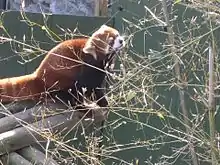
At various times, the red panda was placed in the Procyonidae, Ursidae, with Ailuropoda (giant panda) in the Ailuropodinae (until this family was moved into the Ursidae), and into its own family, the Ailuridae. This uncertainty comes from difficulty in determining whether certain characteristics of Ailurus are phylogenetically conservative or are derived and convergent with species of similar ecological habits.[9]
Evidence based on the fossil record, serology, karyology, behavior, anatomy, and reproduction reflect closer affinities with Procyonidae than Ursidae. However, ecological and foraging specializations and distinct geographical distribution in relation to modern procyonids support classification in the separate family Ailuridae.[6][9][47]
Recent molecular systematic DNA research also places the red panda into its own family, Ailuridae, a part of the broad superfamily Musteloidea that also includes the mephitids (skunks), procyonids (raccoons), and mustelids (weasels).[5][47][48] According to the most recent phylogenetic studies, the red panda's closest relatives within the Musteloidea superfamily are the procyonids and mustelids.[49]
It is not a bear, nor closely related to the giant panda, nor a raccoon, nor a lineage of uncertain affinities. Rather it is a basal lineage of musteloid, with a long history of independence from its closest relatives (skunks, raccoons, and otters/weasels/badgers).
— Flynn et al., Whence the Red Panda?, [5] p. 197
Evolutionary history

The red panda is considered a living fossil and only distantly related to the giant panda (Ailuropoda melanoleuca), as it is naturally more closely related to the other members of the superfamily Musteloidea to which it belongs. The common ancestor of both pandas can be traced back to the Paleogene period tens of millions of years ago, with a wide distribution across Eurasia.
Fossils of the extinct red panda Parailurus anglicus were excavated in sites from China in the east to Britain in the west.[50] In 1977, a single tooth of Parailurus was discovered in the Pliocene Ringold Formation of Washington. This first North American record is almost identical to European specimens and indicates the immigration of this species from Asia.[51] In 2004, a tooth from a red panda species never before recorded in North America was discovered at the Gray Fossil Site in Tennessee. The tooth dates from 4.5–7 million years ago. This species, described as Pristinailurus bristoli, indicates that a second, more primitive ailurine lineage inhabited North America during the Miocene. Cladistic analysis suggests that Parailurus and Ailurus are sister taxa.[50][52] Additional fossils of Pristinailurus bristoli were discovered at the Gray Fossil Site in 2010 and in 2012.[53][54] The discovery in Spain of the postcranial remains of Simocyon batalleri, a Miocene relative to the red panda, supports a sister-group relationship between red pandas and bears. The discovery suggests the red panda's "false thumb" was an adaptation to arboreal locomotion, independent of the giant panda's adaptation to manipulate bamboo, one of the most dramatic cases of convergent evolution among vertebrates.[55]
In 2020, results of a phylogenetic analysis of red panda samples showed that red pandas in China and the Himalayas were separated by a river about 250,000 years ago. Therefore, the two subspecies should be treated as distinct species. The analysed samples showed high levels of population structure across the red panda's range.[7] However, the results of this research should be treated with caution because of the sampling gap of more than 500 km (310 mi) between the two proposed species, and the lack of isolation-by-distance and morphometric analyses. Additionally, the use of the phylogenetic species concept for species delimitation in mammals has been associated with the unnecessary splitting of subspecies into species.[56][57]
Etymology
Ailurus is adopted from the ancient Greek word αἴλουρος (ailouros), meaning "cat".[58] The specific epithet fulgens is Latin for "shining, bright".[59][60]
Panda is a Roman goddess of peace and travellers, who was called upon before starting a difficult journey.[61]
Native names
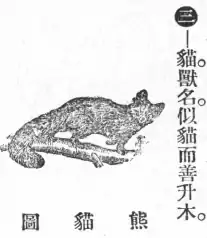
The Lepcha call it sak nam. In Nepal, it is called bhālu birālo (bear-cat) and hābre. The Sherpa people of Nepal and Sikkim call it ye niglva ponva and wah donka.[62] The word wậː is Sunuwari meaning bear; in Tamang language, a small, red bear is called tāwām.[63] In the Kanchenjunga region of eastern Nepal, the Limbu people know red pandas as kaala (literally "dark") because of their underside pelage; villagers of Tibetan origin call them hoptongar.[64]
Additionally, Pocock lists the vernacular names ye and nigálya ponya (Nepal); thokya and thongwa (Limbu); oakdonga or wakdonka and woker (Bhotia); saknam sunam (Lepcha).[8] Nigálya may originate from the Nepali word निङालो niṅālo or nĩgālo, a small bamboo, Arundinaria intermedia, but also refers to a kind of small leopard, or cat-bear.[65] The word pónya may originate from the Nepali पञ्जा pajā ("claw") or पौँजा paũjā ("paw").[66] 'Poonya' also means "eater of bamboo".[67] The name panda could originate from panjā.[68]
In modern Chinese, the red panda is called xiăoxióngmāo (小熊猫 and 小熊貓, lesser or small panda, or literally "little bear cat"),[69] or 红熊猫/紅熊貓 (hóngxióngmāo, red panda or literally "red bear cat").[70]
Cultural depictions
The first known written record of the red panda occurs in a 13th-century Chinese scroll depicting a hunting scene between hunters and the red panda.[29]
The red panda was recognized as the state animal of Sikkim in the early 1990s,[74] and was the mascot of the Darjeeling Tea Festival.[29]
In 2005, Babu, a male red panda at Birmingham Nature Centre in Birmingham, England, escaped[75] and briefly became a media celebrity,[75][76] before being recaptured. He was subsequently voted "Brummie of the Year", the first animal to receive this honor.[75][76] Rusty, a male red panda at the National Zoo in Washington, DC, similarly attracted media attention when he briefly escaped in 2013.[77][78]
The name of the open-source Firefox web browser is said to have been derived from a nickname of the red panda: "fire fox".[79][80]
An anthropomorphic red panda was featured as Master Shifu, the kung fu teacher, in the 2008 film Kung Fu Panda, and its sequels Kung Fu Panda 2 in 2011 and Kung Fu Panda 3 in 2016.[81] The red panda Futa inspired the character of Pabu, the so-called "fire ferret" animal companion (primarily of Bolin), in the U.S. animated TV series The Legend of Korra.[82]
Jetstar Japan uses a red panda mascot character named "Jetta" (ジェッ太).[83]
An anthropomorphic red panda, Retsuko, is the main character of the TV anime and Netflix original series Aggretsuko.[84]
References
- Glatston, A.; Wei, F.; Than Zaw & Sherpa, A. (2015). "Ailurus fulgens". IUCN Red List of Threatened Species. 2015: e.T714A110023718.
- Thomas, O. (1902). "On the Panda of Sze-chuen". Annals and Magazine of Natural History. Seventh Series. X (57): 251–252. doi:10.1080/00222930208678667.
- Flynn (2000), p. 197.
- Glatston, A. R. (2011). Red Panda: Biology and Conservation of the First Panda. Amsterdam, Boston, Heidelberg: Academic Press. ISBN 978-1-4377-7813-7.
- Flynn, J. J.; Nedbal, M. A.; Dragoo, J. W.; Honeycutt, R. L. (2000). "Whence the Red Panda?" (PDF). Molecular Phylogenetics and Evolution. 17 (2): 190–199. doi:10.1006/mpev.2000.0819. PMID 11083933. Archived from the original (PDF) on 23 August 2011. Retrieved 23 September 2009.
- Wozencraft, W.C. (2005). "Species Ailurus fulgens". In Wilson, D.E.; Reeder, D.M (eds.). Mammal Species of the World: A Taxonomic and Geographic Reference (3rd ed.). Johns Hopkins University Press. pp. 532–628. ISBN 978-0-8018-8221-0. OCLC 62265494.
- Hu, Y.; Thapa, A.; Fan, H.; Ma, T.; Wu, Q.; Ma, S.; Zhang, D.; Wang, B.; Li, M.; Yan, L.; Wei, F. (2020). "Genomic evidence for two phylogenetic species and long-term population bottlenecks in red pandas". Science Advances. 6 (9): eaax5751. Bibcode:2020SciA....6.5751H. doi:10.1126/sciadv.aax5751. PMC 7043915. PMID 32133395.
- Pocock, R. I. (1941). "Family Ailuridae". Fauna of British India, including Ceylon and Burma. Mammalia. – Volume 2. London: Taylor and Francis. pp. 250–264.
- Roberts, M. S.; Gittleman, J. L. (1984). "Ailurus fulgens" (PDF). Mammalian Species. 222 (222): 1–8. doi:10.2307/3503840. JSTOR 3503840.
- Fisher, R. E.; Adrian, B.; Clay, E.; Hicks, M. (2008). "The phylogeny of the red panda (Ailurus fulgens): evidence from the hindlimb". Journal of Anatomy. 213 (5): 607–628. doi:10.1111/j.1469-7580.2008.00987.x. PMC 2667555. PMID 19014366.
- Glatston 1994:20
- Choudhury, A. (2001). "An overview of the status and conservation of the red panda Ailurus fulgens in India, with reference to its global status". Oryx. Flora & Fauna International. 35 (3): 250–259. doi:10.1046/j.1365-3008.2001.00181.x.
- Wegge, P. (1976) Himalayan shikar reserves: surveys and management proposals. Field Document No. 5. FAO/NEP/72/002 Project, Kathmandu.
- Sharma, H.P.; Belant, J.L. (2009). "Distribution and observations of Red Pandas Ailurus fulgens fulgens in Dhorpatan Hunting Reserve, Nepal" (PDF). Small Carnivore Conservation. 40: 33–35. Archived from the original (PDF) on 28 July 2011.
- Bolton, M. (1976). Lake Rara National Park management plan. Working Document No. 3. Nepal: FAO/UNDP National Parks and Wildlife Conservation Project.
- Sharma, H. P. (2008). Distribution and conservation status of Red Panda (Ailurus fulgens) in Rara National Park, Nepal. Final Report to People's Trust for Endangered Species (Report). London, UK.
- Ghimire, G.; Pearch, M.; Baral, B.; Thapa, B.; Baral, R. (2019). "The first photographic record of the Red Panda Ailurus fulgens (Cuvier, 1825) from Lamjung District outside Annapurna Conservation Area, Nepal". Journal of Threatened Taxa. 11 (12): 14576–14581. doi:10.11609/jott.4828.11.12.14576-14581.
- Bing Su; Yunxin Fu; Wang, Y.; Li Jin; Chakraborty, R. (2001). "Genetic Diversity and Population History of the Red Panda (Ailurus fulgens) as Inferred from Mitochondrial DNA Sequence Variations". Molecular Biology and Evolution. 18 (6): 1070–1076. doi:10.1093/oxfordjournals.molbev.a003878. PMID 11371595.
- Wei, F.; Feng, Z.; Wang, Z.; Hu, J. (1999). "Current distribution, status and conservation of wild red pandas Ailurus fulgens in China". Biological Conservation. 89 (3): 285–291. doi:10.1016/S0006-3207(98)00156-6.
- Fei, Yuxiang; Hou, Rong; Spotila, James R.; Paladino, Frank V.; Qi, Dunwu; Zhang, Zhihe (17 March 2017). Yue, Bi-Song (ed.). "Metabolic rate of the red panda, Ailurus fulgens, a dietary bamboo specialist". PLOS ONE. 12 (3): e0173274. Bibcode:2017PLoSO..1273274F. doi:10.1371/journal.pone.0173274. ISSN 1932-6203. PMC 5356995. PMID 28306740.
- "Lesser panda standing on two legs charms Japanese zoo". China Daily. 2005. Archived from the original on 2 August 2018. Retrieved 2 August 2018.
- "Red Panda – Diet". Rochester Institute of Technology. Archived from the original on 28 June 2015. Retrieved 6 September 2016.
- "Red Panda". Birmingham Zoo. Retrieved 6 September 2016.
- Wei, F; Feng, Z.; Wang, Z.; Zhou, A.; Hu, J. (1999). "Use of the nutrients in bamboo by the red panda Ailurus fulgens". Journal of Zoology. 248 (4): 535–541. doi:10.1111/j.1469-7998.1999.tb01053.x.
- "Pandas opt for low-cal sweeteners". BBC News. 16 April 2008. Retrieved 8 May 2008.
- Nowak, R. M. (1999). Walker's Mammals of the World. 2 (sixth ed.). Baltimore: Johns Hopkins University Press. pp. 695–696. ISBN 0-8018-5789-9.
- Bradford, A. (2016). "Facts About Red Pandas". Live Science. Retrieved 24 December 2018.
- Yonzon, P. B.; Hunter Jr., M. L.; Shobrak; Habibi (1991). "Conservation of the red panda Ailurus fulgens". Biological Conservation. 58 (57): 85. doi:10.1016/0006-3207(91)90046-C.
- Glatston 1994
- Glatston 1994:11
- World Wildlife Fund. "I'm a good luck charm. That's my bad luck". Archived from the original on 17 December 2009. Retrieved 26 September 2009.
- Massicot, P. (2006). "Animal Info: Red Panda". Retrieved 2 September 2008.
- Glatston 1994:viii
- Bhuju, U. R.; Shakya, P. R.; Basnet, T. B.; Shrestha, S. (2007). Nepal Biodiversity Resource Book. Protected Areas, Ramsar Sites, and World Heritage Sites (PDF). Kathmandu: International Centre for Integrated Mountain Development, Ministry of Environment, Science and Technology, in cooperation with United Nations Environment Programme, Regional Office for Asia and the Pacific. ISBN 978-92-9115-033-5. Archived from the original (PDF) on 26 July 2011.
- Ghimire, N.; Bhatta, S. D., eds. (2010). "Red Pandas from Choyatar". Headlines Himalaya. 138.
- Glatston, A. (2007). Red Panda International Studbook - Ailurus fulgens fulgens held in zoos in 2006 (PDF). Rotterdam Zoo. Retrieved 13 September 2009.
- Glatston, A. (2007). Red Panda International Studbook - Ailurus fulgens styani held in zoos in 2006 (PDF). Rotterdam Zoo. Retrieved 13 September 2009.
- Srivastav, A.; Nigam, P.; Chakraborty, D.; Nayak, A. K. (2009). National Studbook of Red Panda (Ailurus fulgens) (PDF) (Report). Wildlife Institute of India. Archived (PDF) from the original on 3 August 2018. Retrieved 3 August 2018.
- Rangarajan, M. (2009). "Striving for a balance: Nature, power, science and India's Indira Gandhi, 1917–1984". Conservation and Society. 7 (4): 299–312. doi:10.4103/0972-4923.65175.
- Cuvier, F. (1825). "Panda". In Geoffroy Saint-Hilaire, E.; Cuvier, F. (eds.). Histoire naturelle des mammifères, avec des figures originales, coloriées, dessinées d'après des animaux vivans: publié sous l'autorité de l'administration du Muséum d'Histoire naturelle. Tome 5. Paris: A. Belin. p. 3 pages, 1 plate.
- Cuvier, G. (1829). "Le Panda éclatant". Le règne animal distribué d'après son organisation. Tome 1. Chez Déterville, Paris. p. 138.
- Hardwicke, T. (1827). "Description of a new Genus of the Class Mammalia, from the Himalaya Chain of Hills between Nepaul and the Snowy Mountains". The Transactions of the Linnean Society of London. Linnean Society of London. XV: 161–165. doi:10.1111/j.1095-8339.1826.tb00113.x.
- Glover, A. M. (1938). "Genus Ailurus F. Cuvier". The Mammals of China and Mongolia. New York: American Museum of Natural History. pp. 314–317.
- Milne-Edwards, H. (1874). "Table alphabétique". Recherches pour servir à l'histoire naturelle des mammifères comprenant des considérations sur la classification de ces animaux. G. Masson, Paris. p. 394.
- Wozencraft, W. C. (2008). "Family Ailuridae". In Smith, A. T.; Xie, Y. (eds.). A guide to the Mammals of China. Princeton: Princeton University Press. p. 448. ISBN 978-0-691-09984-2.
- Wilson, D. E.; Mittermeier, R. A., eds. (2009). "Red panda (Ailuridae)". Handbook of the Mammals of the World. Volume 1: Carnivores. Barcelona: Lynx Edicions. p. 503. ISBN 978-84-96553-49-1.
- Flynn, J. J.; Finarelli, J. A.; Zehr, S; Hsu, J; Nedbal, M. A. (2005). "Molecular phylogeny of the carnivora (mammalia): assessing the impact of increased sampling on resolving enigmatic relationships". Systematic Biology. 54 (2): 317–337. doi:10.1080/10635150590923326. PMID 16012099.
- Flynn, J. J.; Nedbal, M. A. (1998). "Phylogeny of the Carnivora (Mammalia): Congruence vs incompatibility among multiple data sets". Molecular Phylogenetics and Evolution. 9 (3): 414–426. doi:10.1006/mpev.1998.0504. PMID 9667990. S2CID 41106329.
- Mehta, R. S.; Slater, G. J.; Law, C. J. (2018). "Lineage Diversity and Size Disparity in Musteloidea: Testing Patterns of Adaptive Radiation Using Molecular and Fossil-Based Methods". Systematic Biology. 67 (1): 127–144. doi:10.1093/sysbio/syx047. ISSN 1063-5157. PMID 28472434.
- Naish, D. (2008). "The once mighty red panda empire". Tetrapod Zoology. Archived from the original on 2018-08-05. Retrieved 2018-08-05.
- Tedford, R.H.; Gustafson, E. P. (1977). "First North American record of the extinct panda Parailurus". Nature. 265 (5595): 621–623. Bibcode:1977Natur.265..621T. doi:10.1038/265621a0. S2CID 4214900.
- Wallace, S. C.; Wang, X. (2004). "Two new carnivores from an unusual late Tertiary forest biota in eastern North America". Nature. 431 (7008): 556–559. Bibcode:2004Natur.431..556W. doi:10.1038/nature02819. PMID 15457257. S2CID 4432191.
- Speigel, L. (2010). "Exclusive: Traces of Red Panda Found in Tennessee". AOL News. Archived from the original on 3 January 2011. Retrieved 23 November 2011.
- Barber, R. (2012). "Second red panda skeleton uncovered at Gray Fossil Site". Johnson City Press. Archived from the original on 5 August 2018. Retrieved 5 August 2018.
- Salesa, M. J.; Mauricio, A.; Peigné, S.; Morales, J. (2006). "Evidence of a false thumb in a fossil carnivore clarifies the evolution of pandas". PNAS. 103 (2): 379–382. Bibcode:2006PNAS..103..379S. doi:10.1073/pnas.0504899102. PMC 1326154. PMID 16387860.
- Zachos, F. E. (2013). "Species splitting puts conservation at risk". Nature. 494 (7435): 35. doi:10.1038/494035c. PMID 23389532.
- Zachos, F. E.; Lovari, S. (2013). "Taxonomic inflation and the poverty of the phylogenetic species concept – a reply to Gippoliti and Groves". Hystrix. 24 (2): 142–144. CiteSeerX 10.1.1.935.6918. doi:10.4404/hystrix-24.1-8849.
- Liddell, H. G.; Scott, R. (1940). "αἴλουρος". A Greek-English Lexicon (Revised and augmented ed.). Oxford: Clarendon Press.
- Lewis, C. T. A.; Short, C. (1879). "fulgens". Latin Dictionary (Revised, enlarged, and in great part rewritten ed.). Oxford: Clarendon Press.
- Simpson, D. P. (1979). Cassell's Latin Dictionary (5th ed.). London: Cassell Ltd. ISBN 0-304-52257-0.
- Larousse, P. (1866–77). "Panda ou Pantica". Grand dictionnaire universel du XIXe siècle : français, historique, géographique, mythologique, bibliographique, littéraire, artistique, scientifique. Paris: Larousse et Boyer.
- Shrestha, T. K. (2003) Wildlife of Nepal: a study of renewable resources of Nepal Himalayas. Steven Simpson Books. ISBN 9993359025.
- Hale, A. (ed.) (1973). Clause, sentence, and discourse patterns in selected languages of Nepal 4: Word lists. Summer Institute of Linguistics Publications in Linguistics and Related Fields, 40(4). Norman: Summer Institute of Linguistics of the University of Oklahoma. vii, 314 p. online : see page 110 Archived 15 October 2012 at the Wayback Machine
- Yonzon, P. B. (1996). Status of wildlife in the Kanchenjunga region. A reconnaissance study report. WWF Nepal Program, Kathmandu
- Turner, R. L. (1931). "निङालो". A Comparative and Etymological Dictionary of the Nepali Language. London: K. Paul, Trench, Trübner. p. 344. Retrieved 10 December 2010.
- Turner, R. L. (1931). "पञ्जा". A Comparative and Etymological Dictionary of the Nepali Language. London: K. Paul, Trench, Trübner. p. 359.
- Glatston, A. R. (2010). Red Panda: Biology and Conservation of the First Panda. William Andrew. p. 61. ISBN 978-1-4377-7813-7.
- Catton, C. (1990). Pandas. pp. 4–5. ISBN 0-8160-2331-X.
- "小熊貓". MDBG Chinese-English Dictionary. 2011.
- "紅熊貓". MDBG Chinese-English Dictionary. 2011.
- Holmgren, V. C. (1990). Raccoons. Capra Press. p. 150. ISBN 978-0-88496-312-7.
After the giant panda was named, the original panda needed an identifying adjective. Several were used including "shining panda" as Cuvier had originally labeled it, "true panda," "common panda" — because it was more abundant than the giant, — or "lesser panda" to mark its smaller size.
- Burton, M. (1958). "Polecat and cousin Panda". The Illustrated London News. 233 (2): 1004.
the wide popularity of the giant panda, the claims of the true panda, sometimes called the lesser panda, to distinguish it from its more glamorous rival, are apt to receive less attention than they deserve. At least the true panda has history on its side, for it was known to Europeans long before the giant panda, which was not introduced to us until 1869
- Animal Kingdom. New York Zoological Society. 1972. p. xlii.
It was now obvious that the other panda also needed an official distinguishing adjective for an everyday name-tag. Among those already in use were true panda, shining panda, common panda, red panda, and lesser panda, but there has been little agreement about a single choice.
- "The Official Website of the Government of Sikkim". Government of Sikkim. Retrieved 15 November 2010.
- "Red panda boosts visitor numbers". BBC Online. 24 January 2006. Retrieved 12 January 2011.
- Bounds, Jon. "Brummie of the Year 2005". Birmingham: It's Not Shit. Retrieved 12 January 2011.
- Gabriel, T. (24 June 2013). "A Panda Escapes From the Zoo, and Social Media Swoop In With the Net". New York Times. Retrieved 25 June 2013.
- Day, P. K. (24 June 2013). "Rusty the red panda went missing and ABC News was on the case". Los Angeles Times. Retrieved 25 June 2013.
- "Firefox name FAQ". Mozilla. Archived from the original on 28 February 2012. Retrieved 13 March 2012.
- "Red panda". BBC Nature. Archived from the original on 16 October 2014. Retrieved 20 August 2014.
- Gorman, James (17 August 2015). "Red Pandas Are Adorable and in Trouble". The New York Times. Retrieved 8 November 2017.
- Konietzko, Bryan (28 September 2012). "Years ago, on the Avatar production, ..." Retrieved 29 September 2012.
- "Panda-mania pays off for Jetstar." The Australian. Retrieved on December 25, 2018. Alternative link
- Oi, Mariko (13 February 2017). "The angry red panda that is Japan's new working woman". BBC. Retrieved 28 January 2019.
Further reading
- SSC Mustelid, Viverrid & Procyonid Specialist Group (1994). A. R. Glatston (ed.). The Red Panda, Olingos, Coatis, Raccoons, and Their Relatives (PDF). Gland, Switzerland: IUCN. ISBN 2-8317-0046-9. Retrieved 9 January 2010.
- Pecon-Slattery, J.; O'Brien, S. J. (1995). "Molecular phylogeny of the red panda (Ailurus fulgens)". The Journal of Heredity. Oxford University Press. 86 (6): 413–22. doi:10.1093/oxfordjournals.jhered.a111615. PMID 8568209.
- Mace, G.M. and Balmford, A. (2000). “Patterns and processes in contemporary mammalian extinction.” In Priorities for the Conservation of Mammalian Diversity. Has the Panda had its day?, A. Entwhistle and N. Dunstone (eds). Cambridge University Press, Cambridge. pp. 27–52.
External links
| Wikimedia Commons has media related to: |
| Wikispecies has information related to Ailurus fulgens. |
- "Red Panda Network". Red Panda Network – a non-profit organization dedicated to red panda conservation.
- "Ailurus fulgens". Animal Diversity Web.
- "Red Panda". Animal Info.
- "Ailurus fulgens (Taxonomical Serial No.: 621846)". ITIS (USDA Integrated Taxonomic Information System). Retrieved 24 October 2009.
- Miyashiro (2006). "Background information on the question: "Do Pandas Really Exist?"" (PDF). New Mexico Tech. Archived from the original (PDF) on 13 June 2011. Retrieved 9 January 2010.
- Briggs, H. (2020). "Red pandas are two species, not one". BBC News. Retrieved 27 February 2020.
- Naish, D. (2008). "Nigayla-ponya, firefox, true panda: its life and times". Tetrapod Zoology. Retrieved 9 January 2010.
